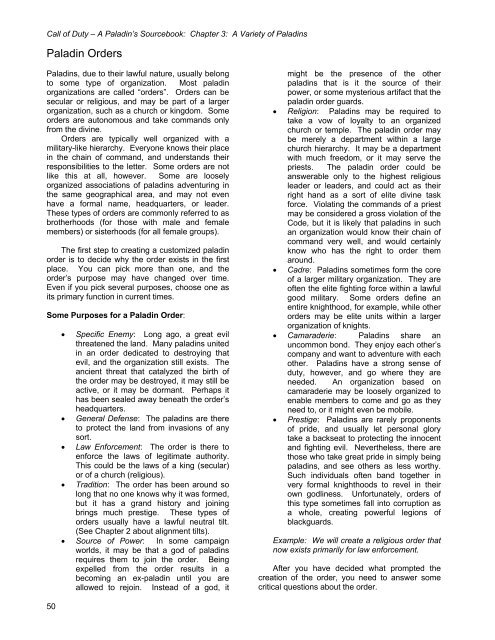DnD/Class Handbooks/Paladins/Call of Duty - Paladin
DnD/Class Handbooks/Paladins/Call of Duty - Paladin
DnD/Class Handbooks/Paladins/Call of Duty - Paladin
Create successful ePaper yourself
Turn your PDF publications into a flip-book with our unique Google optimized e-Paper software.
<strong>Call</strong> <strong>of</strong> <strong>Duty</strong> – A <strong>Paladin</strong>’s Sourcebook: Chapter 3: A Variety <strong>of</strong> <strong><strong>Paladin</strong>s</strong><br />
<strong>Paladin</strong> Orders<br />
<strong><strong>Paladin</strong>s</strong>, due to their lawful nature, usually belong<br />
to some type <strong>of</strong> organization. Most paladin<br />
organizations are called “orders”. Orders can be<br />
secular or religious, and may be part <strong>of</strong> a larger<br />
organization, such as a church or kingdom. Some<br />
orders are autonomous and take commands only<br />
from the divine.<br />
Orders are typically well organized with a<br />
military-like hierarchy. Everyone knows their place<br />
in the chain <strong>of</strong> command, and understands their<br />
responsibilities to the letter. Some orders are not<br />
like this at all, however. Some are loosely<br />
organized associations <strong>of</strong> paladins adventuring in<br />
the same geographical area, and may not even<br />
have a formal name, headquarters, or leader.<br />
These types <strong>of</strong> orders are commonly referred to as<br />
brotherhoods (for those with male and female<br />
members) or sisterhoods (for all female groups).<br />
The first step to creating a customized paladin<br />
order is to decide why the order exists in the first<br />
place. You can pick more than one, and the<br />
order’s purpose may have changed over time.<br />
Even if you pick several purposes, choose one as<br />
its primary function in current times.<br />
Some Purposes for a <strong>Paladin</strong> Order:<br />
50<br />
• Specific Enemy: Long ago, a great evil<br />
threatened the land. Many paladins united<br />
in an order dedicated to destroying that<br />
evil, and the organization still exists. The<br />
ancient threat that catalyzed the birth <strong>of</strong><br />
the order may be destroyed, it may still be<br />
active, or it may be dormant. Perhaps it<br />
has been sealed away beneath the order’s<br />
headquarters.<br />
• General Defense: The paladins are there<br />
to protect the land from invasions <strong>of</strong> any<br />
sort.<br />
• Law Enforcement: The order is there to<br />
enforce the laws <strong>of</strong> legitimate authority.<br />
This could be the laws <strong>of</strong> a king (secular)<br />
or <strong>of</strong> a church (religious).<br />
• Tradition: The order has been around so<br />
long that no one knows why it was formed,<br />
but it has a grand history and joining<br />
brings much prestige. These types <strong>of</strong><br />
orders usually have a lawful neutral tilt.<br />
(See Chapter 2 about alignment tilts).<br />
• Source <strong>of</strong> Power: In some campaign<br />
worlds, it may be that a god <strong>of</strong> paladins<br />
requires them to join the order. Being<br />
expelled from the order results in a<br />
becoming an ex-paladin until you are<br />
allowed to rejoin. Instead <strong>of</strong> a god, it<br />
might be the presence <strong>of</strong> the other<br />
paladins that is it the source <strong>of</strong> their<br />
power, or some mysterious artifact that the<br />
paladin order guards.<br />
• Religion: <strong><strong>Paladin</strong>s</strong> may be required to<br />
take a vow <strong>of</strong> loyalty to an organized<br />
church or temple. The paladin order may<br />
be merely a department within a large<br />
church hierarchy. It may be a department<br />
with much freedom, or it may serve the<br />
priests. The paladin order could be<br />
answerable only to the highest religious<br />
leader or leaders, and could act as their<br />
right hand as a sort <strong>of</strong> elite divine task<br />
force. Violating the commands <strong>of</strong> a priest<br />
may be considered a gross violation <strong>of</strong> the<br />
Code, but it is likely that paladins in such<br />
an organization would know their chain <strong>of</strong><br />
command very well, and would certainly<br />
know who has the right to order them<br />
around.<br />
• Cadre: <strong><strong>Paladin</strong>s</strong> sometimes form the core<br />
<strong>of</strong> a larger military organization. They are<br />
<strong>of</strong>ten the elite fighting force within a lawful<br />
good military. Some orders define an<br />
entire knighthood, for example, while other<br />
orders may be elite units within a larger<br />
organization <strong>of</strong> knights.<br />
• Camaraderie: <strong><strong>Paladin</strong>s</strong> share an<br />
uncommon bond. They enjoy each other’s<br />
company and want to adventure with each<br />
other. <strong><strong>Paladin</strong>s</strong> have a strong sense <strong>of</strong><br />
duty, however, and go where they are<br />
needed. An organization based on<br />
camaraderie may be loosely organized to<br />
enable members to come and go as they<br />
need to, or it might even be mobile.<br />
• Prestige: <strong><strong>Paladin</strong>s</strong> are rarely proponents<br />
<strong>of</strong> pride, and usually let personal glory<br />
take a backseat to protecting the innocent<br />
and fighting evil. Nevertheless, there are<br />
those who take great pride in simply being<br />
paladins, and see others as less worthy.<br />
Such individuals <strong>of</strong>ten band together in<br />
very formal knighthoods to revel in their<br />
own godliness. Unfortunately, orders <strong>of</strong><br />
this type sometimes fall into corruption as<br />
a whole, creating powerful legions <strong>of</strong><br />
blackguards.<br />
Example: We will create a religious order that<br />
now exists primarily for law enforcement.<br />
After you have decided what prompted the<br />
creation <strong>of</strong> the order, you need to answer some<br />
critical questions about the order.


